Skeleton Based Action Recognition
Skeleton-based Action Recognition is a computer-vision task that involves recognizing human actions from a sequence of 3D skeletal joint data captured from sensors such as Microsoft Kinect, Intel RealSense, and wearable devices. The goal of skeleton-based action recognition is to develop algorithms that can understand and classify human actions from skeleton data, which can be used in various applications such as human-computer interaction, sports analysis, and surveillance.
Papers and Code
LORTSAR: Low-Rank Transformer for Skeleton-based Action Recognition
Jul 19, 2024


The complexity of state-of-the-art Transformer-based models for skeleton-based action recognition poses significant challenges in terms of computational efficiency and resource utilization. In this paper, we explore the application of Singular Value Decomposition (SVD) to effectively reduce the model sizes of these pre-trained models, aiming to minimize their resource consumption while preserving accuracy. Our method, LORTSAR (LOw-Rank Transformer for Skeleton-based Action Recognition), also includes a fine-tuning step to compensate for any potential accuracy degradation caused by model compression, and is applied to two leading Transformer-based models, "Hyperformer" and "STEP-CATFormer". Experimental results on the "NTU RGB+D" and "NTU RGB+D 120" datasets show that our method can reduce the number of model parameters substantially with negligible degradation or even performance increase in recognition accuracy. This confirms that SVD combined with post-compression fine-tuning can boost model efficiency, paving the way for more sustainable, lightweight, and high-performance technologies in human action recognition.
SA-DVAE: Improving Zero-Shot Skeleton-Based Action Recognition by Disentangled Variational Autoencoders
Jul 18, 2024



Existing zero-shot skeleton-based action recognition methods utilize projection networks to learn a shared latent space of skeleton features and semantic embeddings. The inherent imbalance in action recognition datasets, characterized by variable skeleton sequences yet constant class labels, presents significant challenges for alignment. To address the imbalance, we propose SA-DVAE -- Semantic Alignment via Disentangled Variational Autoencoders, a method that first adopts feature disentanglement to separate skeleton features into two independent parts -- one is semantic-related and another is irrelevant -- to better align skeleton and semantic features. We implement this idea via a pair of modality-specific variational autoencoders coupled with a total correction penalty. We conduct experiments on three benchmark datasets: NTU RGB+D, NTU RGB+D 120 and PKU-MMD, and our experimental results show that SA-DAVE produces improved performance over existing methods. The code is available at https://github.com/pha123661/SA-DVAE.
Shap-Mix: Shapley Value Guided Mixing for Long-Tailed Skeleton Based Action Recognition
Jul 17, 2024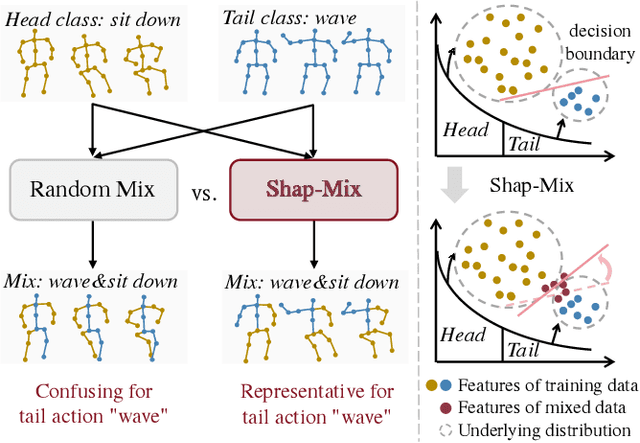

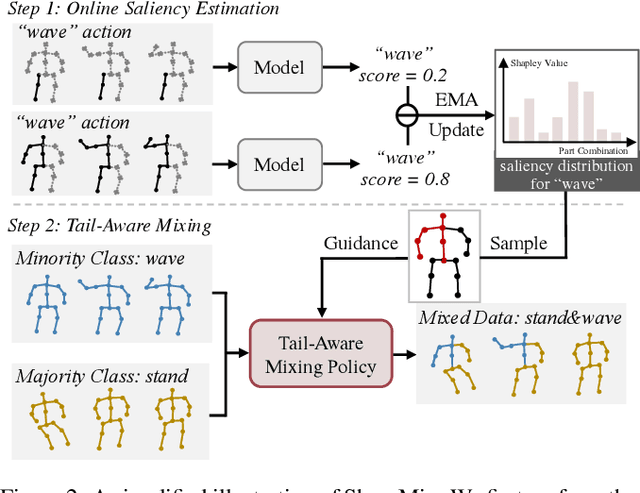

In real-world scenarios, human actions often fall into a long-tailed distribution. It makes the existing skeleton-based action recognition works, which are mostly designed based on balanced datasets, suffer from a sharp performance degradation. Recently, many efforts have been madeto image/video long-tailed learning. However, directly applying them to skeleton data can be sub-optimal due to the lack of consideration of the crucial spatial-temporal motion patterns, especially for some modality-specific methodologies such as data augmentation. To this end, considering the crucial role of the body parts in the spatially concentrated human actions, we attend to the mixing augmentations and propose a novel method, Shap-Mix, which improves long-tailed learning by mining representative motion patterns for tail categories. Specifically, we first develop an effective spatial-temporal mixing strategy for the skeleton to boost representation quality. Then, the employed saliency guidance method is presented, consisting of the saliency estimation based on Shapley value and a tail-aware mixing policy. It preserves the salient motion parts of minority classes in mixed data, explicitly establishing the relationships between crucial body structure cues and high-level semantics. Extensive experiments on three large-scale skeleton datasets show our remarkable performance improvement under both long-tailed and balanced settings. Our project is publicly available at: https://jhang2020.github.io/Projects/Shap-Mix/Shap-Mix.html.
Expressive Keypoints for Skeleton-based Action Recognition via Skeleton Transformation
Jun 26, 2024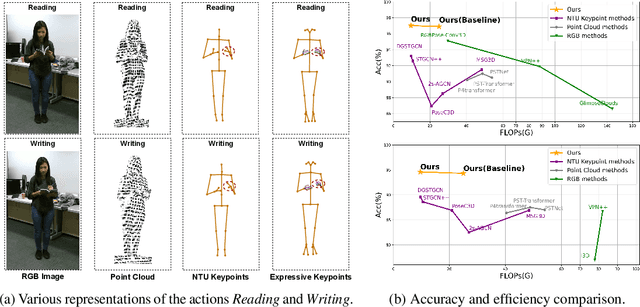

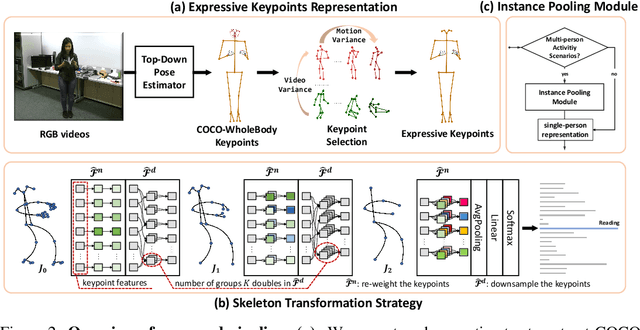

In the realm of skeleton-based action recognition, the traditional methods which rely on coarse body keypoints fall short of capturing subtle human actions. In this work, we propose Expressive Keypoints that incorporates hand and foot details to form a fine-grained skeletal representation, improving the discriminative ability for existing models in discerning intricate actions. To efficiently model Expressive Keypoints, the Skeleton Transformation strategy is presented to gradually downsample the keypoints and prioritize prominent joints by allocating the importance weights. Additionally, a plug-and-play Instance Pooling module is exploited to extend our approach to multi-person scenarios without surging computation costs. Extensive experimental results over seven datasets present the superiority of our method compared to the state-of-the-art for skeleton-based human action recognition. Code is available at https://github.com/YijieYang23/SkeleT-GCN.
Mask and Compress: Efficient Skeleton-based Action Recognition in Continual Learning
Jul 01, 2024The use of skeletal data allows deep learning models to perform action recognition efficiently and effectively. Herein, we believe that exploring this problem within the context of Continual Learning is crucial. While numerous studies focus on skeleton-based action recognition from a traditional offline perspective, only a handful venture into online approaches. In this respect, we introduce CHARON (Continual Human Action Recognition On skeletoNs), which maintains consistent performance while operating within an efficient framework. Through techniques like uniform sampling, interpolation, and a memory-efficient training stage based on masking, we achieve improved recognition accuracy while minimizing computational overhead. Our experiments on Split NTU-60 and the proposed Split NTU-120 datasets demonstrate that CHARON sets a new benchmark in this domain. The code is available at https://github.com/Sperimental3/CHARON.
Boosting Adversarial Transferability for Skeleton-based Action Recognition via Exploring the Model Posterior Space
Jul 11, 2024Skeletal motion plays a pivotal role in human activity recognition (HAR). Recently, attack methods have been proposed to identify the universal vulnerability of skeleton-based HAR(S-HAR). However, the research of adversarial transferability on S-HAR is largely missing. More importantly, existing attacks all struggle in transfer across unknown S-HAR models. We observed that the key reason is that the loss landscape of the action recognizers is rugged and sharp. Given the established correlation in prior studies~\cite{qin2022boosting,wu2020towards} between loss landscape and adversarial transferability, we assume and empirically validate that smoothing the loss landscape could potentially improve adversarial transferability on S-HAR. This is achieved by proposing a new post-train Dual Bayesian strategy, which can effectively explore the model posterior space for a collection of surrogates without the need for re-training. Furthermore, to craft adversarial examples along the motion manifold, we incorporate the attack gradient with information of the motion dynamics in a Bayesian manner. Evaluated on benchmark datasets, e.g. HDM05 and NTU 60, the average transfer success rate can reach as high as 35.9\% and 45.5\% respectively. In comparison, current state-of-the-art skeletal attacks achieve only 3.6\% and 9.8\%. The high adversarial transferability remains consistent across various surrogate, victim, and even defense models. Through a comprehensive analysis of the results, we provide insights on what surrogates are more likely to exhibit transferability, to shed light on future research.
STARS: Self-supervised Tuning for 3D Action Recognition in Skeleton Sequences
Jul 15, 2024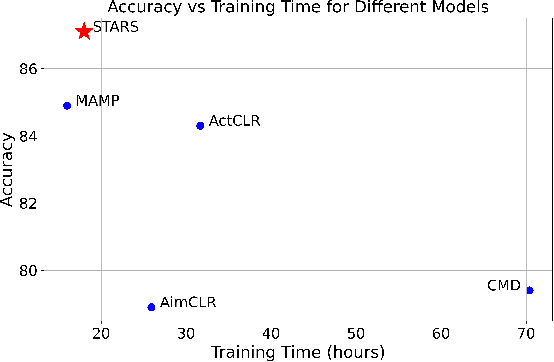
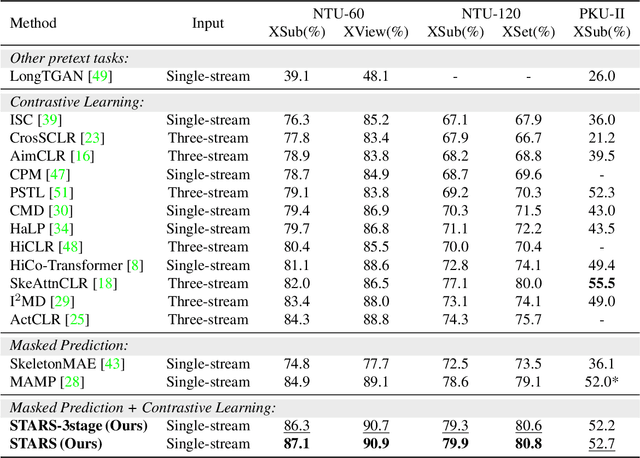
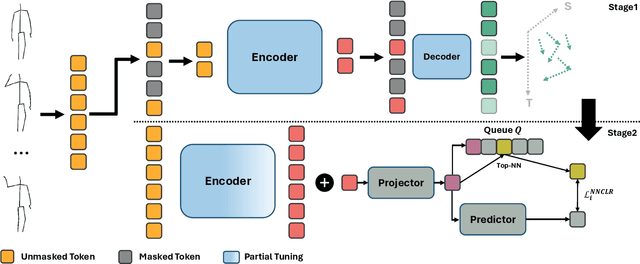
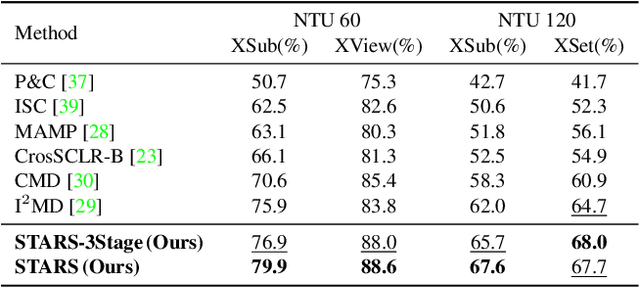
Self-supervised pretraining methods with masked prediction demonstrate remarkable within-dataset performance in skeleton-based action recognition. However, we show that, unlike contrastive learning approaches, they do not produce well-separated clusters. Additionally, these methods struggle with generalization in few-shot settings. To address these issues, we propose Self-supervised Tuning for 3D Action Recognition in Skeleton sequences (STARS). Specifically, STARS first uses a masked prediction stage using an encoder-decoder architecture. It then employs nearest-neighbor contrastive learning to partially tune the weights of the encoder, enhancing the formation of semantic clusters for different actions. By tuning the encoder for a few epochs, and without using hand-crafted data augmentations, STARS achieves state-of-the-art self-supervised results in various benchmarks, including NTU-60, NTU-120, and PKU-MMD. In addition, STARS exhibits significantly better results than masked prediction models in few-shot settings, where the model has not seen the actions throughout pretraining. Project page: https://soroushmehraban.github.io/stars/
TASAR: Transferable Attack on Skeletal Action Recognition
Sep 04, 2024Skeletal sequences, as well-structured representations of human behaviors, are crucial in Human Activity Recognition (HAR). The transferability of adversarial skeletal sequences enables attacks in real-world HAR scenarios, such as autonomous driving, intelligent surveillance, and human-computer interactions. However, existing Skeleton-based HAR (S-HAR) attacks exhibit weak adversarial transferability and, therefore, cannot be considered true transfer-based S-HAR attacks. More importantly, the reason for this failure remains unclear. In this paper, we study this phenomenon through the lens of loss surface, and find that its sharpness contributes to the poor transferability in S-HAR. Inspired by this observation, we assume and empirically validate that smoothening the rugged loss landscape could potentially improve adversarial transferability in S-HAR. To this end, we propose the first Transfer-based Attack on Skeletal Action Recognition, TASAR. TASAR explores the smoothed model posterior without re-training the pre-trained surrogates, which is achieved by a new post-train Dual Bayesian optimization strategy. Furthermore, unlike previous transfer-based attacks that treat each frame independently and overlook temporal coherence within sequences, TASAR incorporates motion dynamics into the Bayesian attack gradient, effectively disrupting the spatial-temporal coherence of S-HARs. To exhaustively evaluate the effectiveness of existing methods and our method, we build the first large-scale robust S-HAR benchmark, comprising 7 S-HAR models, 10 attack methods, 3 S-HAR datasets and 2 defense models. Extensive results demonstrate the superiority of TASAR. Our benchmark enables easy comparisons for future studies, with the code available in the supplementary material.
An Information Compensation Framework for Zero-Shot Skeleton-based Action Recognition
Jun 02, 2024



Zero-shot human skeleton-based action recognition aims to construct a model that can recognize actions outside the categories seen during training. Previous research has focused on aligning sequences' visual and semantic spatial distributions. However, these methods extract semantic features simply. They ignore that proper prompt design for rich and fine-grained action cues can provide robust representation space clustering. In order to alleviate the problem of insufficient information available for skeleton sequences, we design an information compensation learning framework from an information-theoretic perspective to improve zero-shot action recognition accuracy with a multi-granularity semantic interaction mechanism. Inspired by ensemble learning, we propose a multi-level alignment (MLA) approach to compensate information for action classes. MLA aligns multi-granularity embeddings with visual embedding through a multi-head scoring mechanism to distinguish semantically similar action names and visually similar actions. Furthermore, we introduce a new loss function sampling method to obtain a tight and robust representation. Finally, these multi-granularity semantic embeddings are synthesized to form a proper decision surface for classification. Significant action recognition performance is achieved when evaluated on the challenging NTU RGB+D, NTU RGB+D 120, and PKU-MMD benchmarks and validate that multi-granularity semantic features facilitate the differentiation of action clusters with similar visual features.
A Comprehensive Methodological Survey of Human Activity Recognition Across Divers Data Modalities
Sep 15, 2024Human Activity Recognition (HAR) systems aim to understand human behaviour and assign a label to each action, attracting significant attention in computer vision due to their wide range of applications. HAR can leverage various data modalities, such as RGB images and video, skeleton, depth, infrared, point cloud, event stream, audio, acceleration, and radar signals. Each modality provides unique and complementary information suited to different application scenarios. Consequently, numerous studies have investigated diverse approaches for HAR using these modalities. This paper presents a comprehensive survey of the latest advancements in HAR from 2014 to 2024, focusing on machine learning (ML) and deep learning (DL) approaches categorized by input data modalities. We review both single-modality and multi-modality techniques, highlighting fusion-based and co-learning frameworks. Additionally, we cover advancements in hand-crafted action features, methods for recognizing human-object interactions, and activity detection. Our survey includes a detailed dataset description for each modality and a summary of the latest HAR systems, offering comparative results on benchmark datasets. Finally, we provide insightful observations and propose effective future research directions in HAR.
 Add to Chrome
Add to Chrome Add to Firefox
Add to Firefox Add to Edge
Add to Edge